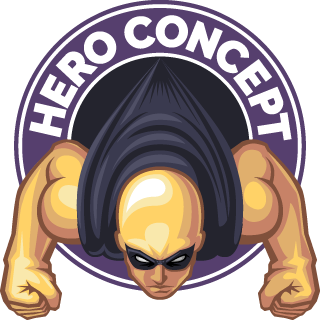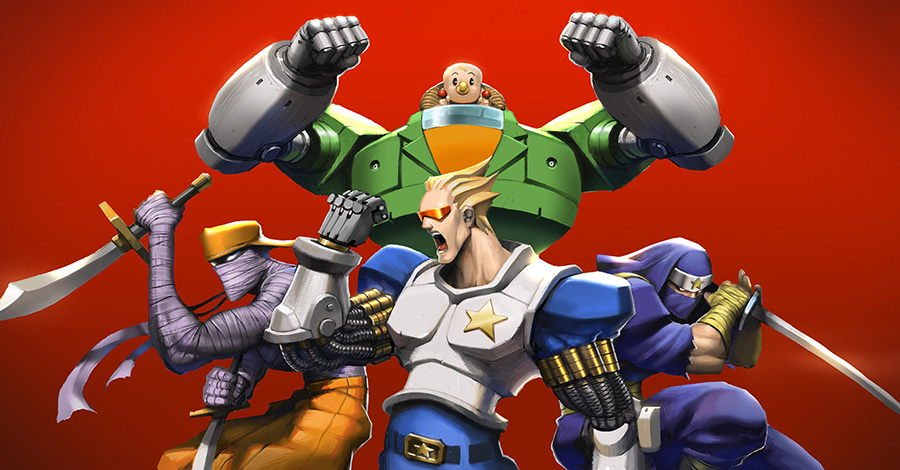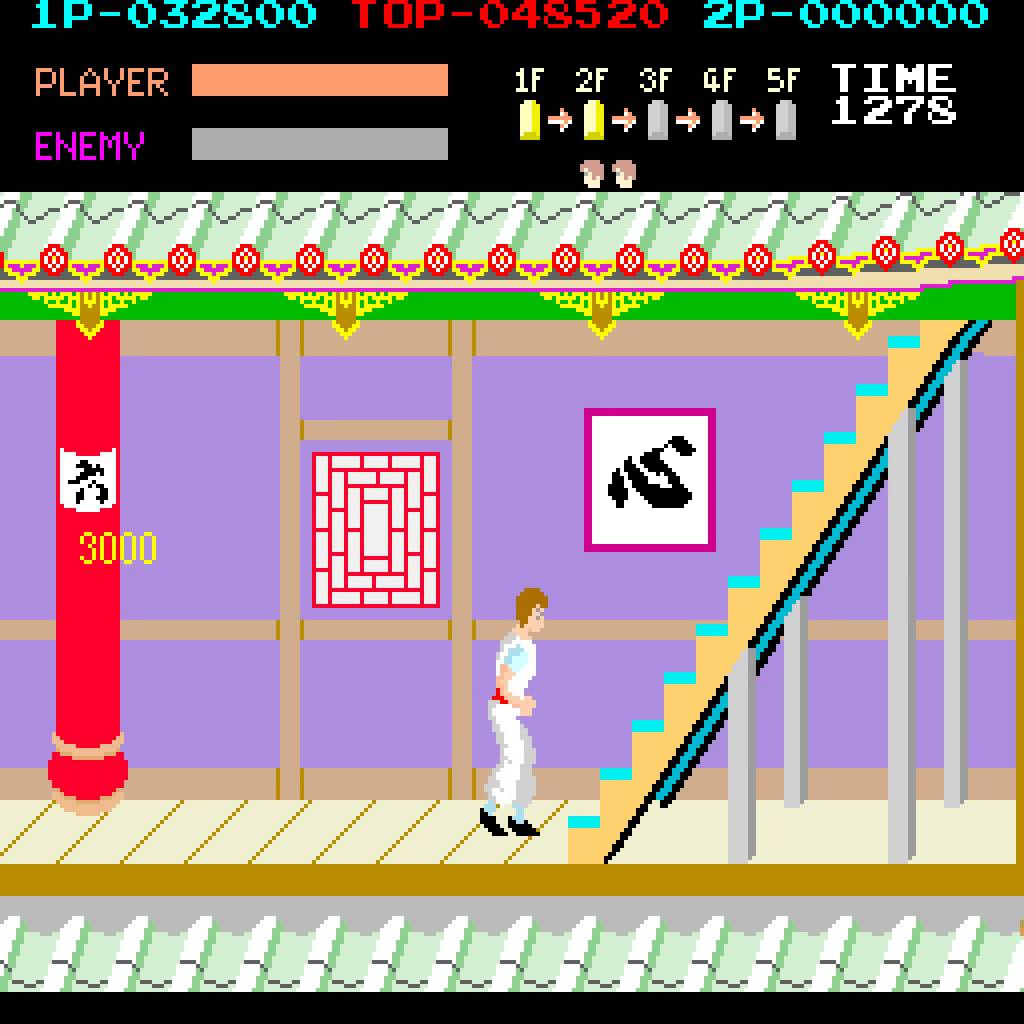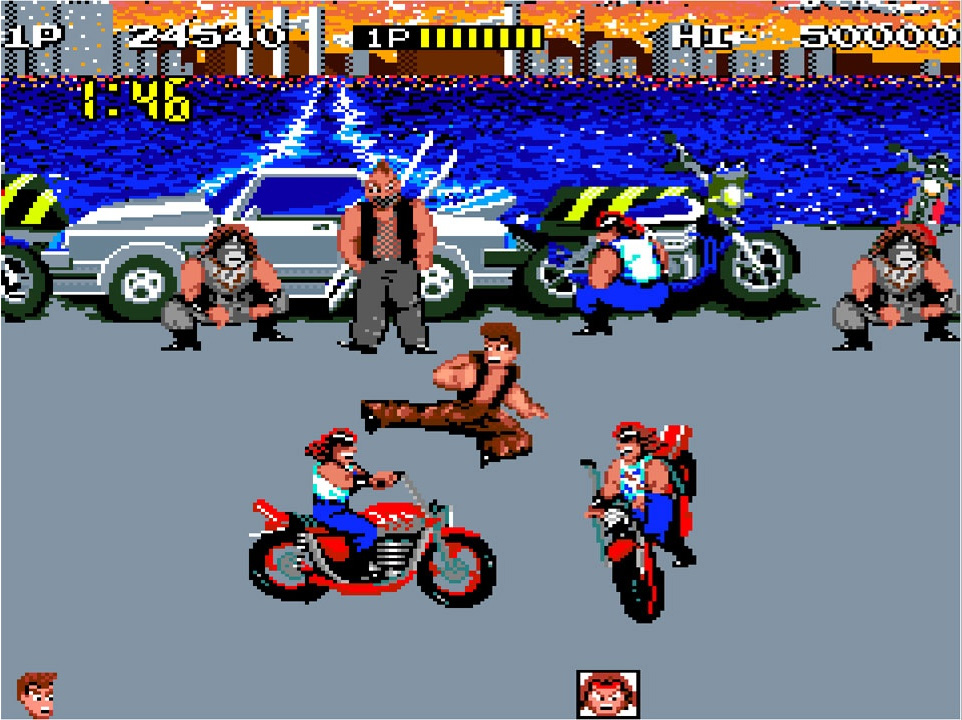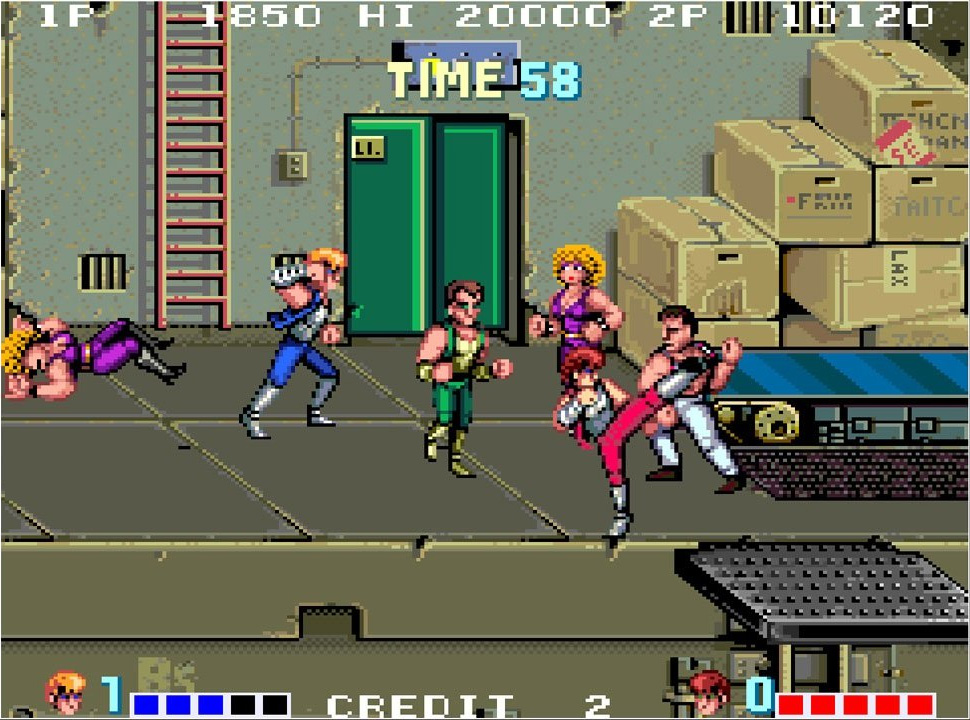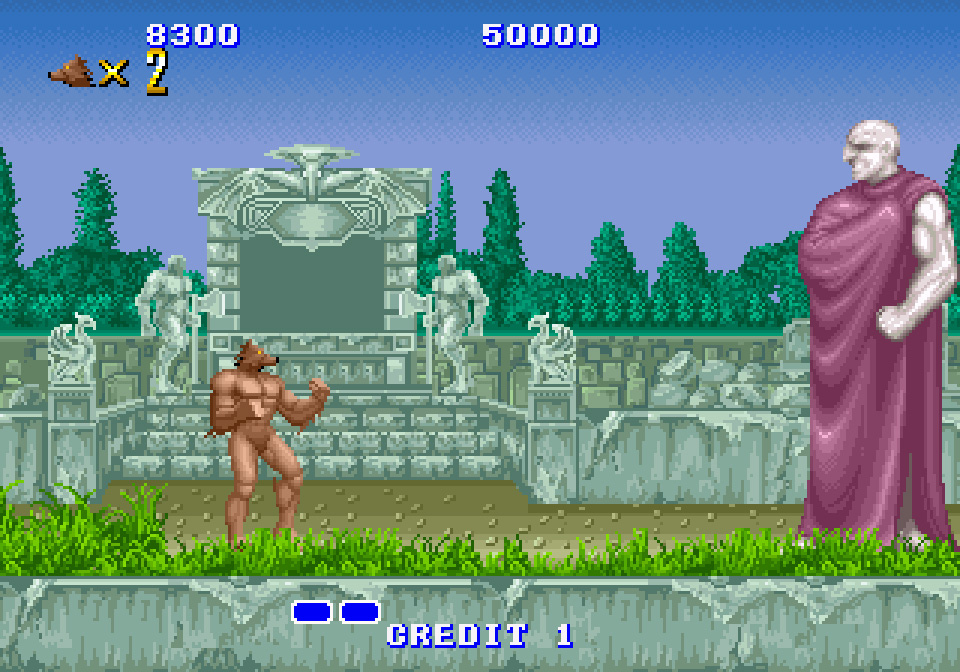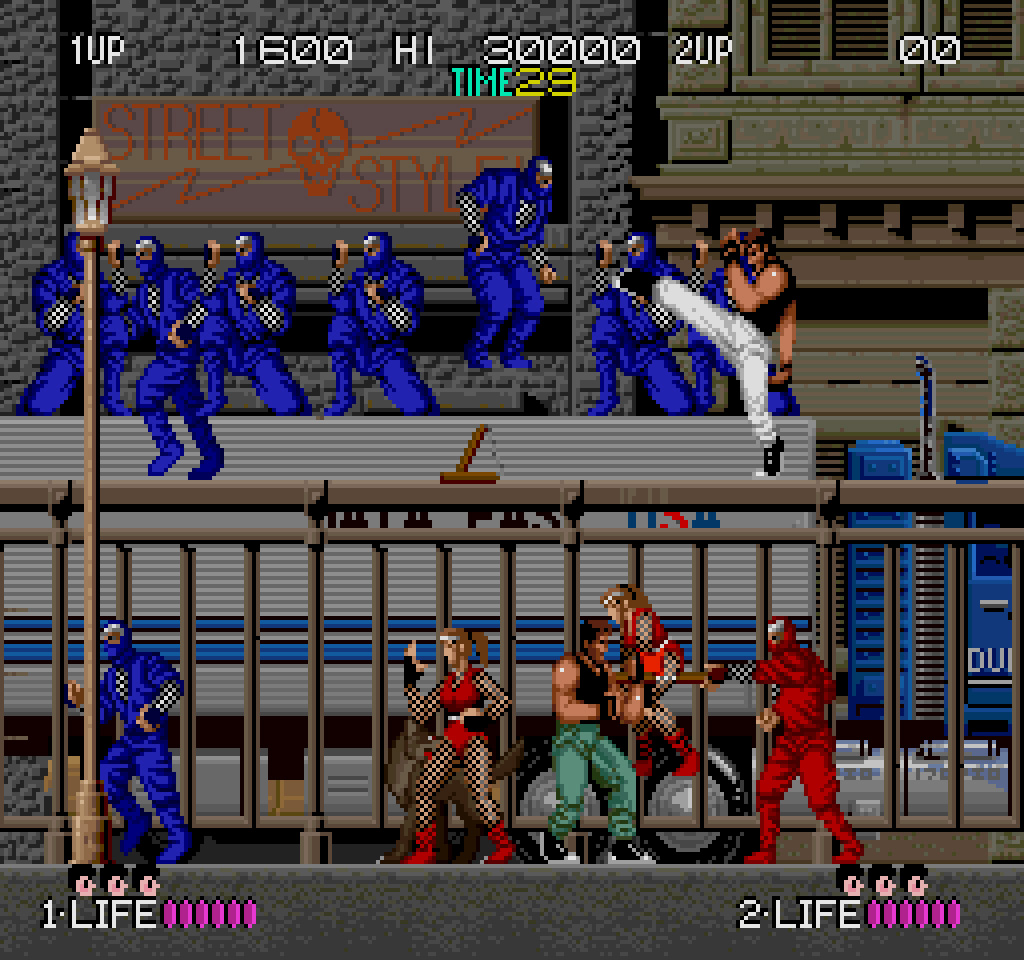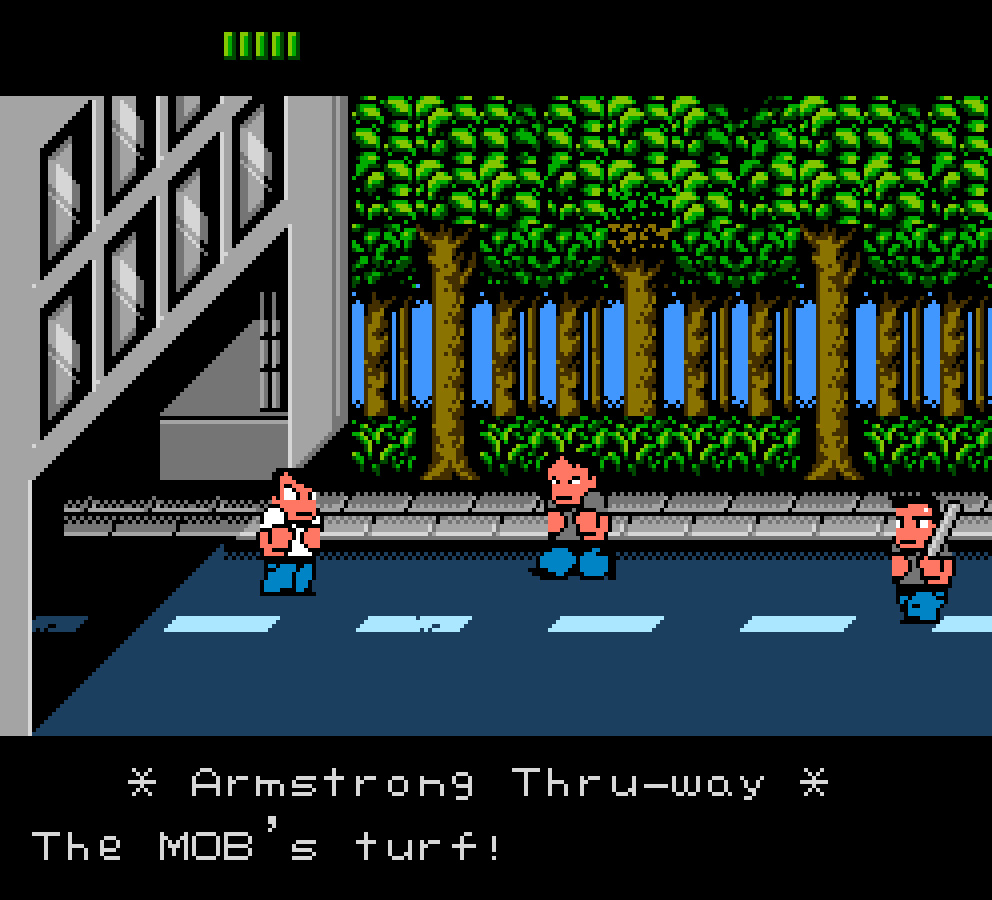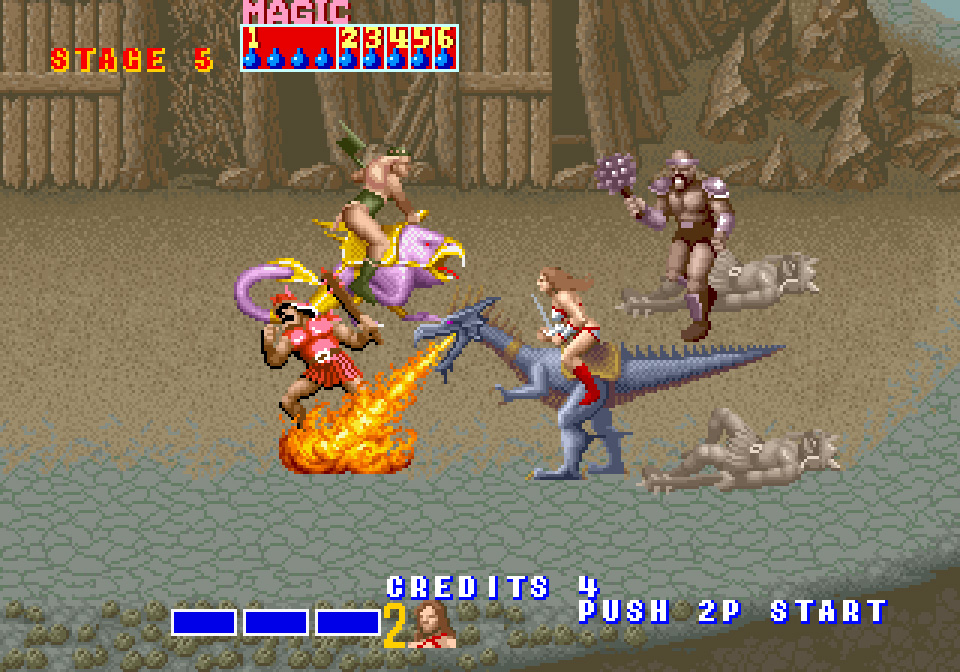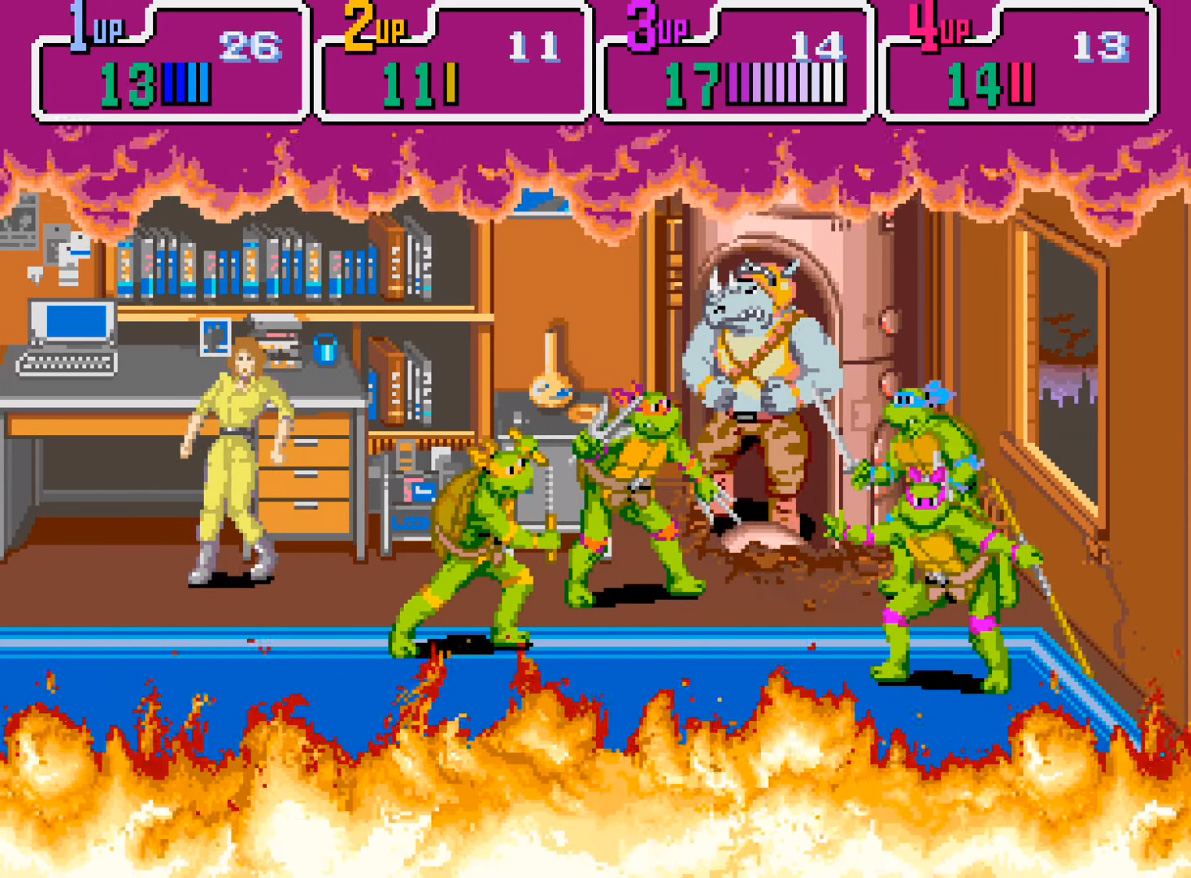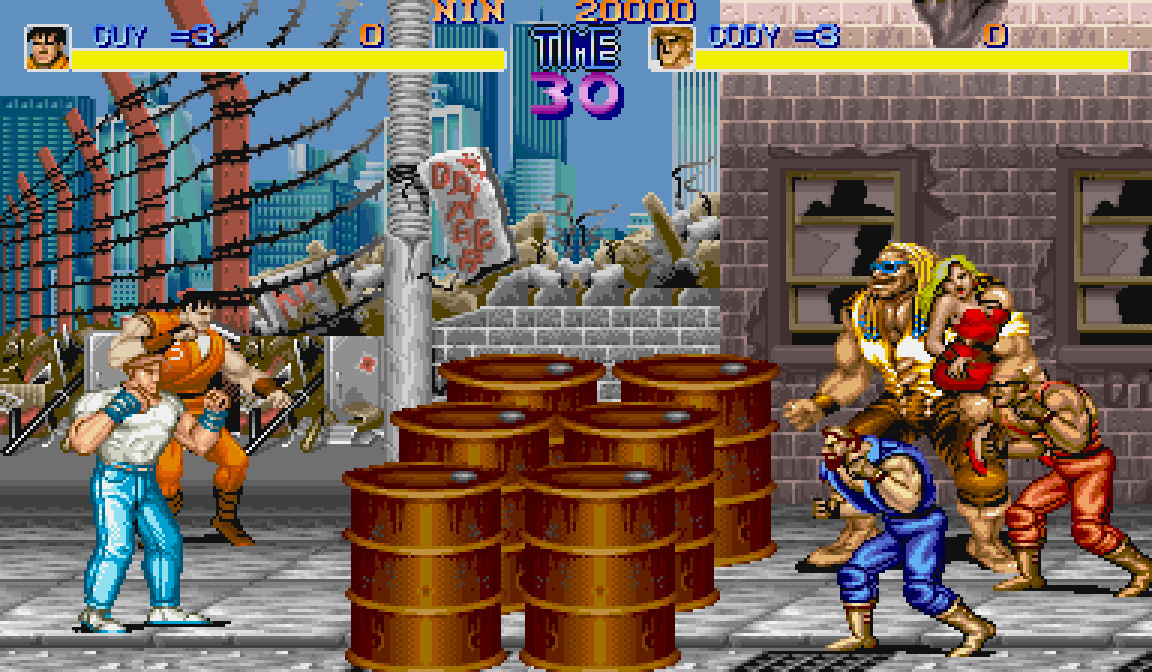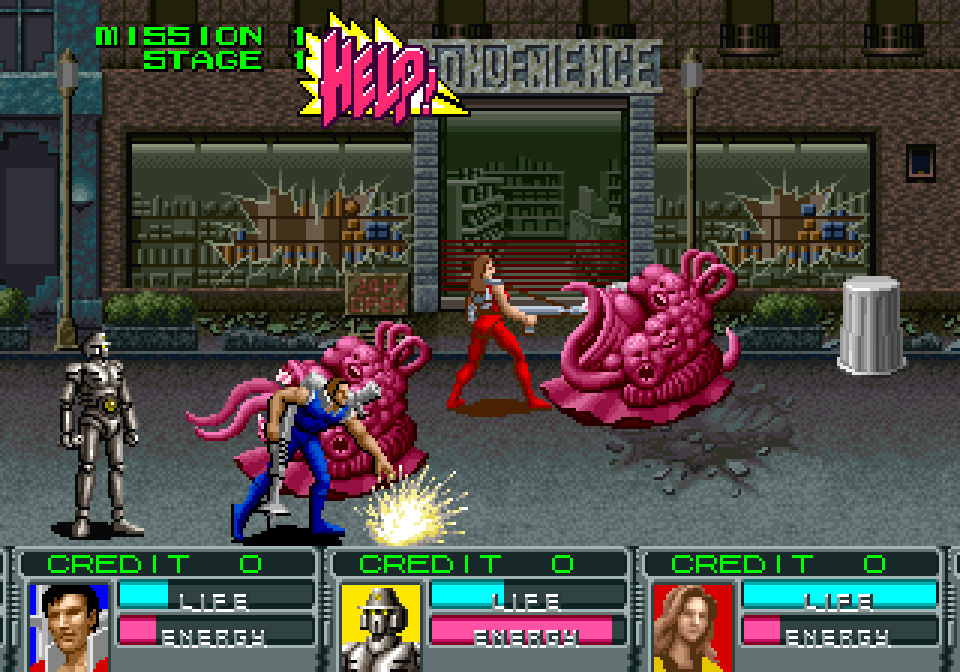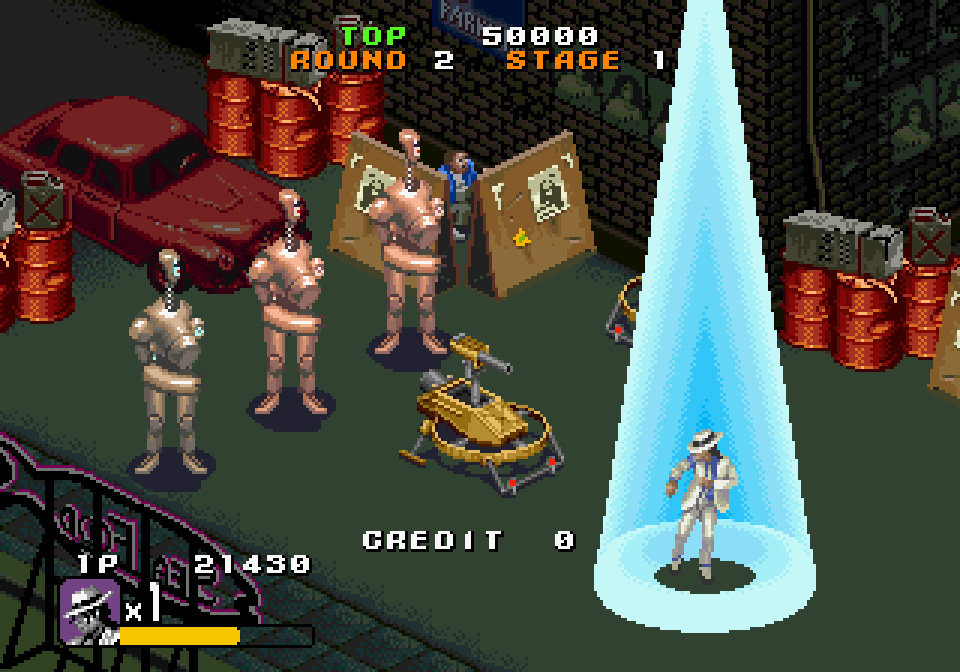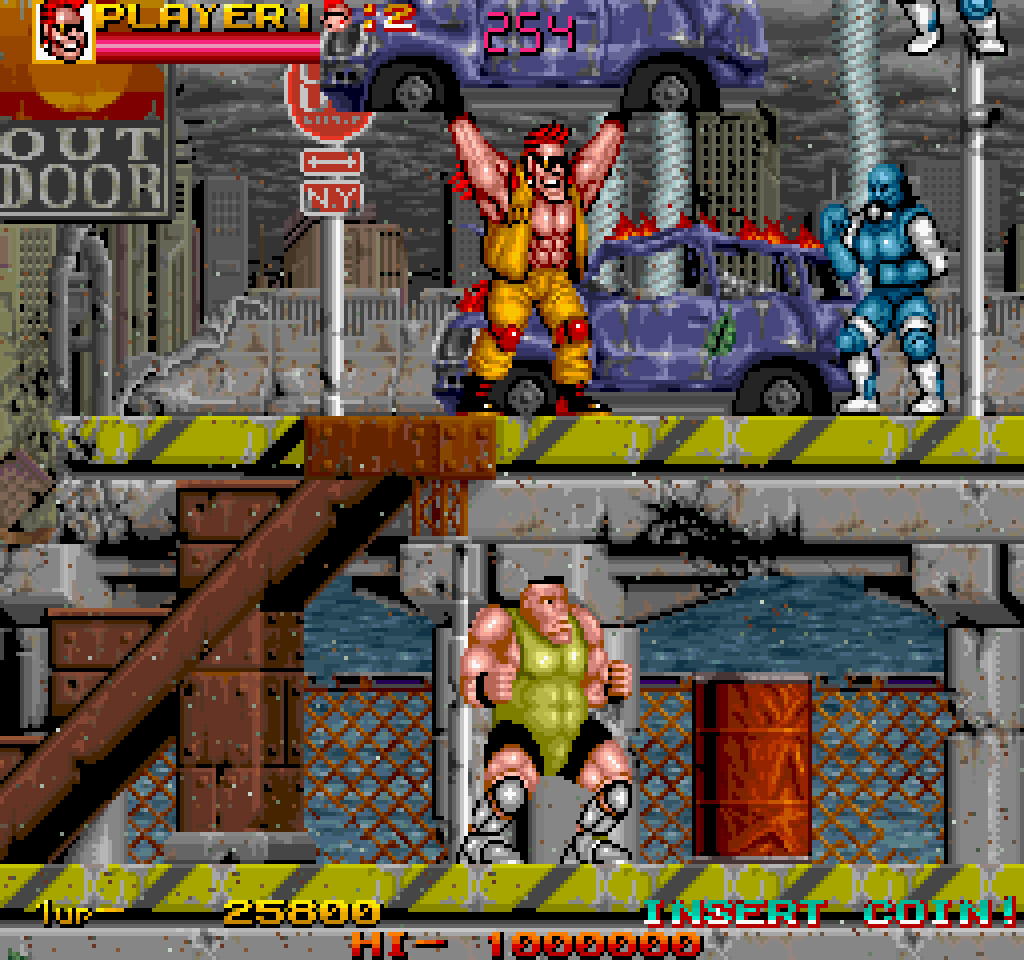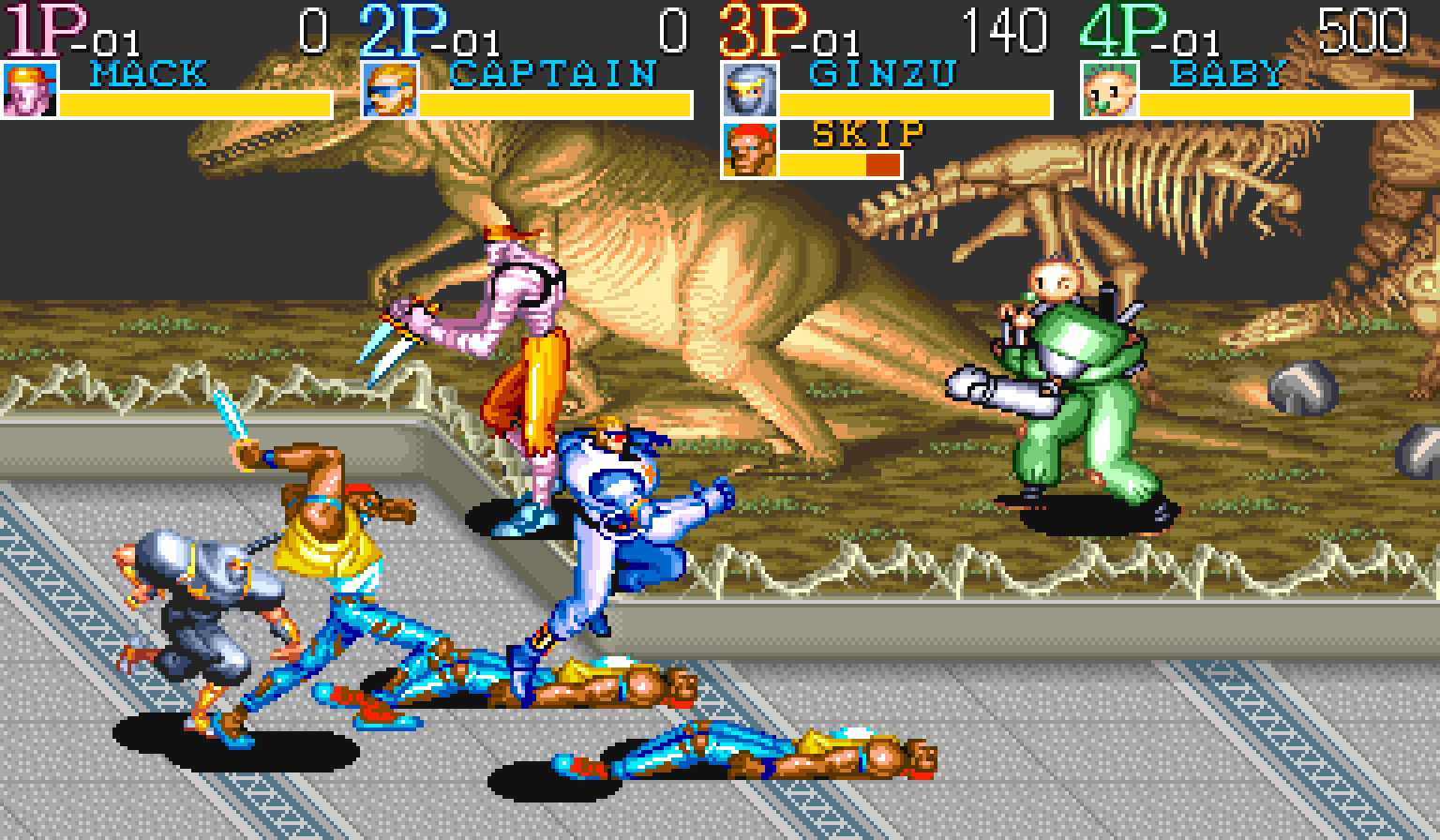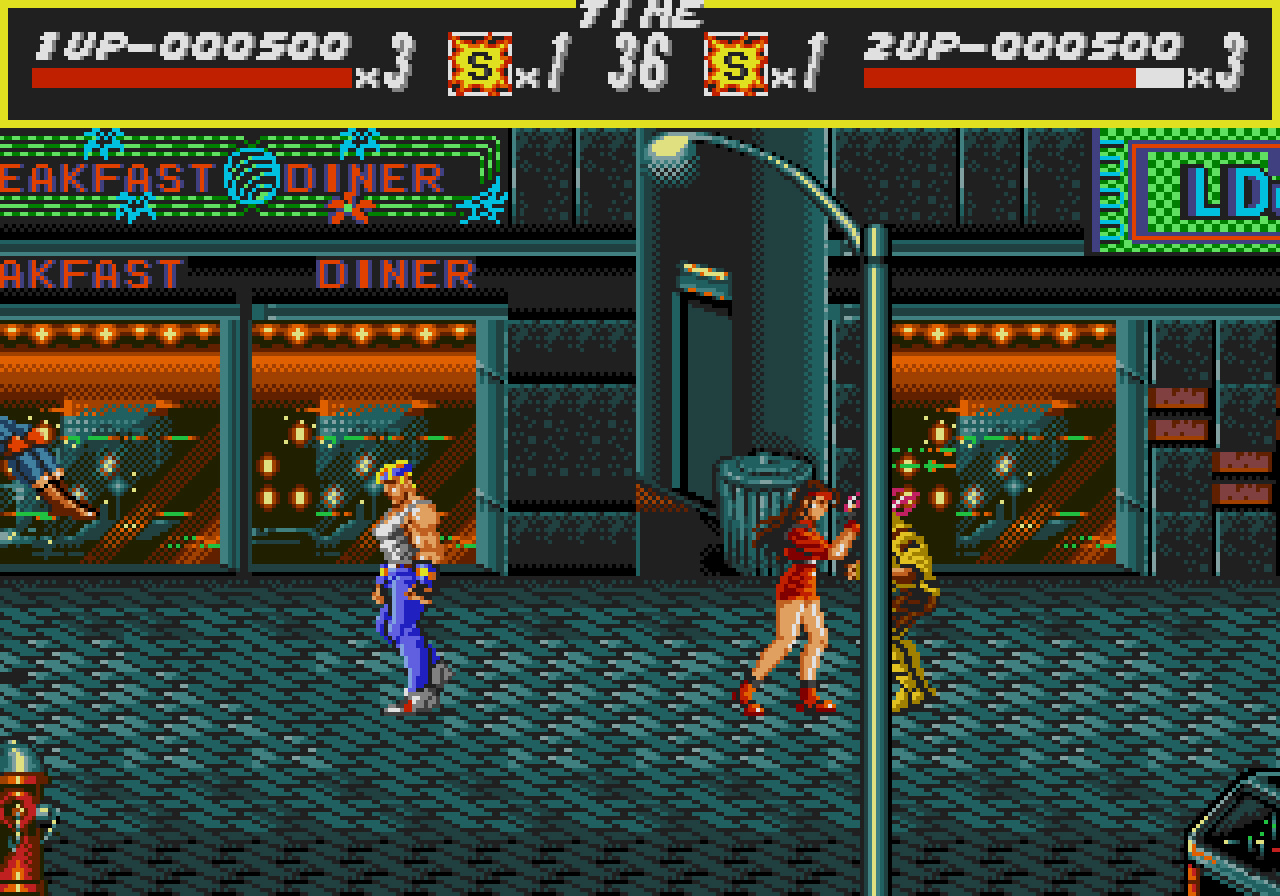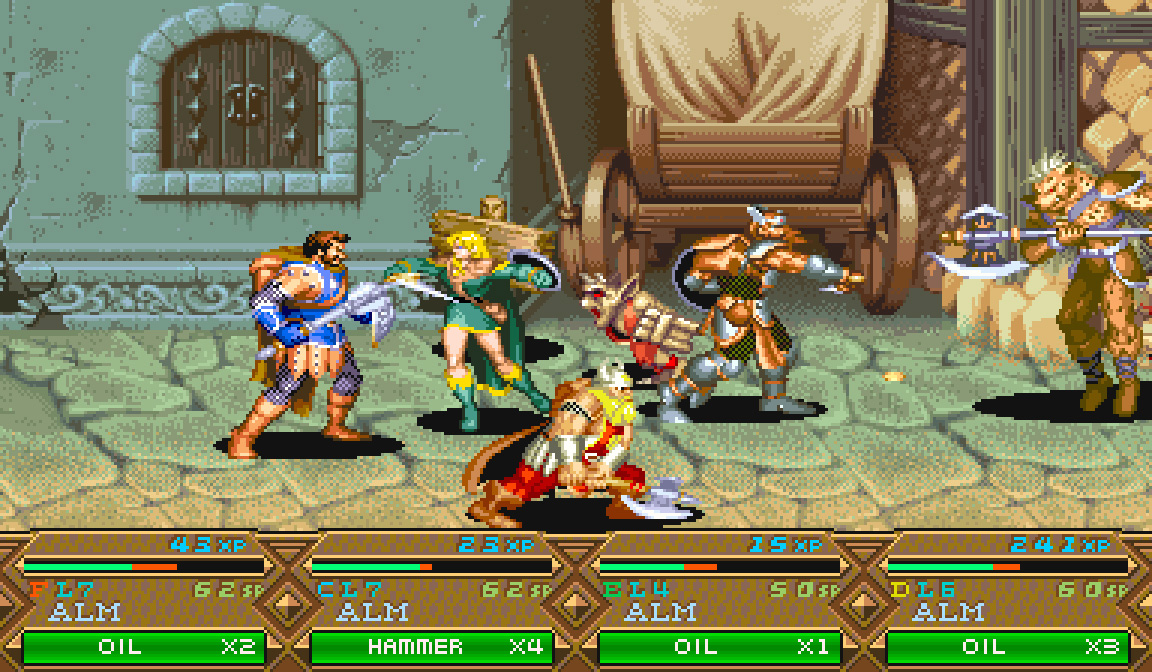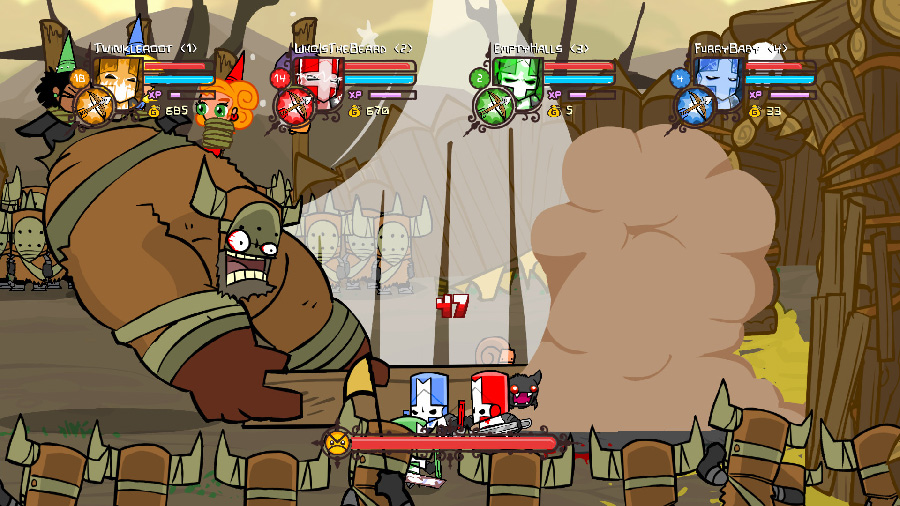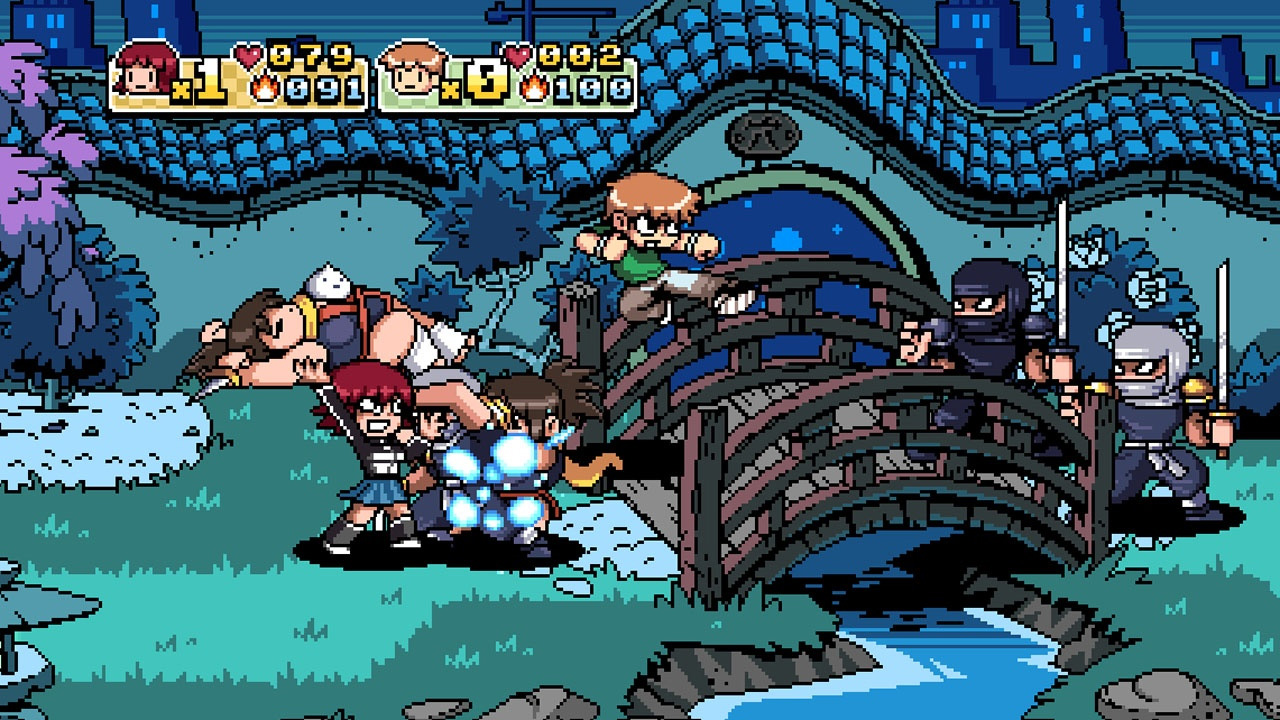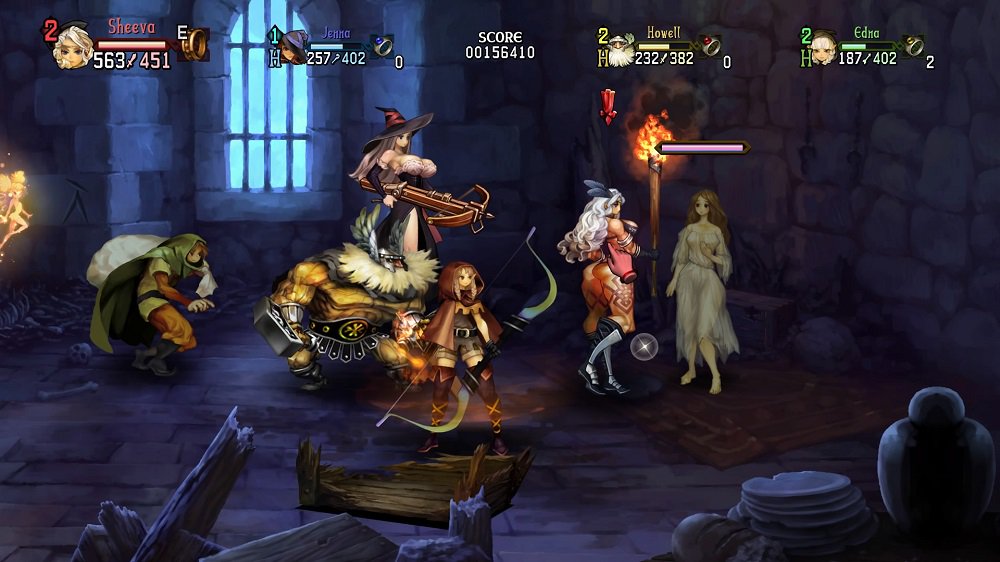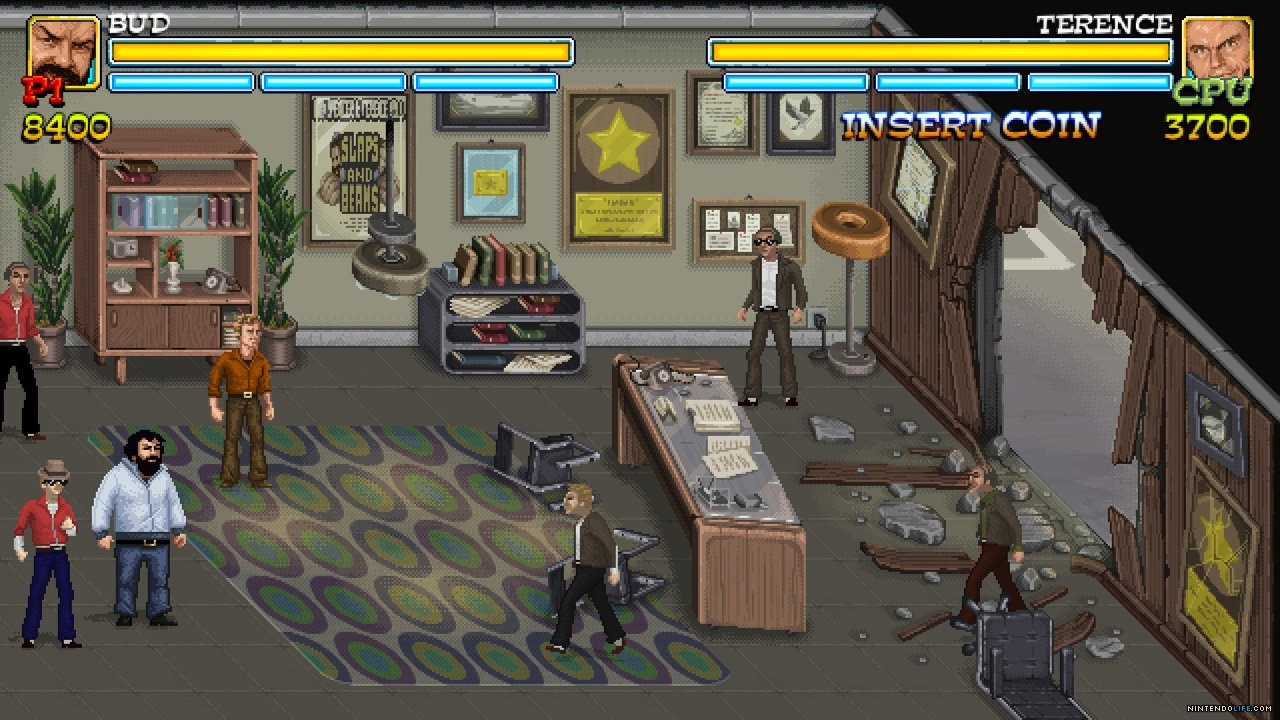Greetings Brawlers! While our team is excited for the release of Mayhem Brawler, we would like to take a look at the brief history of Beat ’em Up games and see how they impacted the gaming industry and how they gave inspiration along with the knowledge to nowadays companies. Stay awhile and learn more about the milestones of the Beat ’em Up genre.
First and foremost; the names that gathered up for this article are to inform you about the milestones in the history of the genre, not to give you a list of the most popular among them. That said, you may not find some of the games which you loved in the first half of the ’90s. You have been warned, don’t point your fingers at me like “where is that game where we run over badland thugs with a shiny car and beat giant lizards with our bare fists?”, “How can you not include that reborn classic?” or you’ll face my Captain Sword!
Early Representatives (1984 – 1986)
In platformer games, the characters use the X (horizontal) and Y (vertical) axis, while the side-scrolling beat’em up’s use the X (horizontal) and Z (depth) axis to walk around. Companies that used the Y-axis in their game mechanics are a minority. That being said, two games initially defined the genre, which created two different styles to be followed by the side-scrolling beat ’em ups with differentiation between the use of playgrounds. The title Kung-Fu Master remained loyal to its platforming ancestors by using only the X and Y-axis on the field with no depth. Meanwhile, the Renegade added the Z-axis to the field and kept the playground on the X and Y-axis.
Kung-Fu Master (1984)
Developed by “Irem Corp” and released in 1984, “Kung Fu Master” (also known as Spartan X in the Japanese version) is more like a fighting-themed platformer game. However, it went down in history as the first beat ’em up that emphasizes the combat theme based on mechanics over the interaction of enemies with the player, almost eliminating the platformer elements.
As the Kung Fu Master Thomas, you try to save his kidnapped girlfriend Silvia from a building with five floors filled with opponents. The game only includes 5 enemy varieties along with individual bosses appearing at the end of each floor. Kung Fu Master can be completed in an average of 7 to 8 minutes.
The game has originally designed for being the video game of Bruce Lee’s 1972 movie “Game of Death”. However, the company wanted the game to bear a more recent movie title which was Jackie Chan’s “Spartan X” from 1984. Even though it bears the title of the name, there are no other similarities between the two whatsoever.
Another significant detail that I’d like to mention is how Legendary the game’s designer is; Takashi Nishiyama, who created “Street Fighter”, “Fatal Fury: King of Fighters”, “Art of Fighting”, “The King of Fighters ‘94”, and “Samurai Showdown” in the following years.
Renegade (1986)
Although the “Kung Fu Master” is considered to be the first Beat ‘em, the 1986 production “Renegade” developed by “Technos Japan” was the game that defined the genre.
Renegade is about a street fighter named “Mr. K” trying to save his girlfriend from a group of gangsters. The stages consist of four parts, each areas expanding slightly to the right and left as you beat up opponents. Along with 2 different types of enemies, there are last bosses to face in each section. These gang leaders will be watching the fight impatiently and menacingly from the background and entering the fray after Mr. K beats up a certain amount of opponents.
The most important feature of “Renegade” is that it deepens the playing field towards the Z-axis. Mechanics that have been implemented to this title has been an inspiration for the future beat ’em up games. Double-tap forward to dash, grab and perform special grab attacks (right on the groins) or throws, get on top of the fallen enemies to pummel them, throwing or letting enemies fall into the pits to dispose of them quickly, and finally, minions executing a full nelson to the player which leaves them vulnerable while other minions take advantage of it, hammering our character. These implements were used in this title for the first time.
The franchise had two other sequels: “Target Renegade (1988)” and “Renegade III: The Final Chapter (1989)” and these titles tarnished the name of the first game. Although the sequels did not release for the arcades, they were published for the home consoles
And lastly as a side note: Renegade was inspired by the 1979 movie “The Warriors.”
Golden Age (1987 – 1991)
The golden age of side-scrolling beat ’em ups begins with “Double Dragon” in 1987. Almost every new game released during this period contributed to the development of the genre. Each of them added something above the previous one.
Double Dragon (1987)
Right after the creation of Renegade, Tecnhos Japan published the “Double Dragon” in 1987. It marked the beginning of the golden age of the beat ’em up genre. Yet again the game greets us with a familiar story. The gang kidnaps a woman (named Marian) and our hero(es) Billy and Jimmy fight their way fiercely to save her.
“Technos Japan” took many elements that were successful in “Renegade” and improved it by adding important features, such as weapons like baseball bats that can be taken from the opponents, being able to throw objects such as barrels, and most importantly; a 2-player co-op mode to beat up bullies with your friends. Even though it contained a ton of bugs, the game was a great success for the studio. The biggest inspiration of multiplayer beat ’em up games that made a mark in history is none other than the notorious “Double Dragon” on the arcade.
When I said, “a ton of bugs” I wasn’t even exaggerating. For that, the headbutts and jump-back kicks the playable characters execute are downright useless. The enemy artificial intelligence is quite inadequate. But I’ve saved the best for the last; the infamous “Elbow Smash”! Upon pressing the attack and jump buttons simultaneously, the characters executed a rare elbow strike where opponents couldn’t protect themselves against. Players around the world soon discovered that they could finish the entire game like a cakewalk by only using the Elbow Smash.
Perhaps the developer team was aware of all these issues, or they simply wanted to take advantage of the success of the game right away, “Technos Japan” published “Double Dragon II: The Revenge” very next year. With improved graphics, new enemies to beat up, already great music from the first game made even better, and the fighting system literally perfected, the game took its spot on the arcades.
Unfortunately, Double Dragon’s arcade career ended with a very poor sequel in 1990’s “Double Dragon 3: The Rosetta Stone.” Nevertheless, several games that carry on the Double Dragon name continued to be produced over the years, most notably for the Nintendo Consoles. In fact, thanks to the retro gaming trend that has resurfaced in the last few years, “Double Dragon: Neon” has been released for the consoles in 2012 and Steam in 2014 as a parody of the series.
The Ninja Warriors (1987)
“Taito’s” 1987 production “The Ninja Warriors” continued the tradition of not having the Z-axis like its predecessor “Kung Fu Master” and presented itself as a very stylish game in the arcade halls.
Compared to other beat ‘em ups, it contains a fairly interesting plot as well; President of the United States of America Bangler, declared martial law in the country in 1993. A group of “anarchist” scientists creates two androids named “Kunoichi” & “Ninja” and sends them to fight against the Bangler. (I know it’s rubbish, but still a better plot than the kidnapped girl incident!)
Up to 2 players can play the game simultaneously. The ninja droids have a limited amount of shurikens as a ranged weapon and daggers (kunai) to cut up soldiers in their arsenal. The ability to block bullets with Kunai was an innovation for the beat ’em up genre. However, one cannot help but think that “anarchic scientists were smart enough to make androids, but wasn’t smart enough to find something more useful than a dagger”. Regardless, the reason why this game is on the list is not because of how good it looked or how incredible of a soundtrack it had back in the day. It took the spot thanks to its insanely designed screen!
The game field was as big as three 4:3 CRT monitors. Due to the mechanics of the game, this visuality gave great results. However, the studio faced some difficulties considering the technological competence back in the day. To be specific; It wasn’t possible to produce a monolithic monitor at the wanted rate with the CRT technology of those years. Putting 3 monitors directly next to each other would not work well either, since it was not possible to produce a frameless monitor at that time. But thanks to creativity fueled by enthusiasm, the solution found was truly magnificent! Two monitors were placed at the right and left ends, and a mirror was positioned against the middle screen to reflect a third monitor placed horizontally in front of it! If you couldn’t visualize the design in your head, you might want to check out this video.
Altered Beast (1988)
The “Altered Beast”, which bears the signature of Makato Uchida, one of “Sega’s” talented designers and whose name you will hear a few more times in this article, has introduced the new “altering” system which gave the playable character unique powers throughout the game. Clashing against mythological creatures rather than dated street thugs made the game all the more astonishing back in the day.
In the story, the goddess Athena is abducted into the Underworld by a demon named Neff. Athena’s father Zeus is forbidden to enter the Underworld. Hence, he raises a once-dead Roman soldier from his grave and orders him to save his daughter. We are accustomed to these types of stories, but this time the kidnapped girl is a goddess! Fancy huh?
Just like its predecessor “Kung-Fu Master”, it’s a beat ‘em up without Z-axis and up to 2 players can play the game together. Characters have fists and kicks in their arsenal against their opponents. Upon defeating albino two-headed wolfs, players can receive a Spirit Ball that will alter and power up the character in phases. After collecting three spirit balls, we witness a small cinematic where our hero turns into a werewolf. It’s been successfully reflected how the hero’s change in the game affects the strength of the character. It’s almost impossible not to get exhilarated after the transformation is complete.
Players distinctly turn into a werewolf, weredragon, werebear, weretiger, and a much stronger variant of the first transformation, the gold werewolf differing in every five stages.
The game contains a very interesting after-credits scene as well. Showing the player a couple of “behind the scene” shots, revealing the fact that the whole game was actually a movie shooting.
Bad Dudes Vs. DragonNinja (1988)
Now brace yourselves for the next title “Bad Dudes Vs. DragonNinja”, which holds a sincerely original story. President of the United States Ronnie (Ronald Raegan) is kidnapped by the evil ninja leader DragonNinja. The legendary secret organization, which is in charge of protecting the President, assigned two street fighters named Blade and Striker, who are known as Bad Dudes in the streets, to rescue the President. Alright fine, don’t get infuriated now, obviously, the reason why this game is on the list is not because of the story.
Bad Dudes Vs. DragonNinja was published by “Data East” in 1988. Yet another successor of the “Kung-Fu Master”, since there is no depth in the playground. It has been a game that uses platformer elements much more active than other titles. It features double-layered stages and players can strategically relocate themselves however they want. Additionally, some stages contain a truck and a freight train as a platform which added a unique atmosphere to the game.
Our opponents who are all ninjas often fall with a single strike. With a race against time structured level design, bosses show up right in time to disperse the wearisomeness of the gameplay. Punches, kicks, and characters’ ability to use weapons such as knives and nunchaku on the road are no different from other beat ‘em up titles.
The first time ever in beat ’em up, an interesting feature has been included which is generally used in shoot ’em ups. Upon holding down the punch button, Blade and Striker gather chi in their palms and execute fiery punches, reminiscent of “Marvel’s Iron Fist”. This punch not only deals greater damage but also affects a larger area to strike multiple enemies. Apart from all these additions, “Bad Dudes Vs. DragonNinja” is the first beat ‘em up to use an object to heal your character, if I’m not mistaken that is. These recovery items are presented as cans of coke.
One last anecdote: The first boss of the game is the protagonist of an older platformer game from “Data East”, “Karnov”. Additionally, when Karnov arrives, the music playing in the background shifts to reminisce the music of the first episode of the game.
River City Ransom (1989)
Released after “Renegade” and “Super Dodge Ball” as a sequel for the Kunio-Kun series in 1989, River City Ransom is an interesting side-scrolling beat ’em up experimentation that features RPG and open-world elements. Yet again the good old narrative strikes back with our high school students Alex and Ryan trying to save Ryan’s girlfriend and battle against the gang leader Slick to save the city.
The combat mechanics feel like a slightly simpler “Double Dragon” at first. What sets this title apart from it is to grow stronger as you progress through the game. To be specific; With the money dropped from the bad guys you’ve beaten, you can purchase books to learn new moves and meals to increase the physical statistics of the characters.
The players can go anywhere in the city as they please, to fight against the gang members, or to shop in the stores whenever they want. Though not as much as today’s complex open worlds, in its time, it was a mind-blowing execution for a beat ‘em up. Due to its long playtime, River City Ransom was never released for the arcades and could only be playable for the home consoles.
Golden Axe (1989)
“Golden Axe” is the project where Makoto Uchida (Developer of “Sega’s” fascinating game “Altered Beast”) literally surpassed himself in the industry. Taking the genre to a mythological era from the uncanny streets of “Altered Beast”, Uchida now brings us players to the realm of sword and sorcery.
Golden Axe narrates the story of three warriors who want to avenge their relatives that got murdered by the relentless dictator Death Adder, ruler of the Yuria realm. These warriors are; Ax-Battler reminiscent of Conan the Barbarian, Tyris Flare who is evocative of Red Sonja, and dwarf Gilius Thunderhead with a battle-ax in his hand.
“Golden Axe” has brought 3 major revolutionary innovations to the genre. Up until that point, each beat ‘em up game allowed the character with the alternative color palette for the second player. Meanwhile, “Golden Axe” offered 3 different-looking characters with unique gameplay mechanics allowing 2 players to enjoy the game cooperatively. These 3 playable characters possess magical powers that can damage all enemies on the screen, and they differ both visually and mechanically. Lastly, and perhaps the most exciting innovation is the rideable monsters! There are 3 different mounts in the game that the characters can ride, which is an absolute joy to use.
Due to its popularity, “Golden Axe” got ported to many devices just like the other titles and published sequels throughout the years. The most interesting of these is “Golden Axe: Beast Rider”, a game made exclusively for PlayStation 3 in 2008 with mount-based gameplay mechanics and Tyris Flare as its protagonist.
Teenage Mutant Ninja Turtles (1989)
In an era where beat ’em ups were so popular, it didn’t take too long before the big titles hop on the stage to get their fair share of the cake. There is a game among them that deserves to be on this list that I cannot pass without mentioning! “Konami’s” “Teenage Mutant Ninja Turtles”, which was released in October 1989.
This title is a very entertaining game that reflects the style of the cartoon series from 1987. Fighting mechanics meet the standards of its period. The four characters are very different from each other both visually and mechanically. Donatello’s range is slightly longer but he is cumbersome, Michaelangelo and Raphael execute short-ranged fast attacks, and in terms of range and speed, Leonardo is the most balanced turtle of them all.
The biggest reason for the game to make it on this list is nothing more than the fact that up to 4 people can play the game simultaneously! A group of four people, controlling a turtle and beating bad guys in front of the arcade machine. Cowabunga!
Final Fight (1989)
Capcom’s “Final Fight” is known as the best beat ’em up ever with the highest commercial success and innovations in the genre. The title was published a few months after the release of Golden Axe.
This project was actually developed to be a sequel for “Street Fighter” from 1987 with the name “Street Fighter ’89”. However, it was necessary to keep up with the rapidly changing industry at that time. The success of the “Double Dragon” series is taken into consideration, changing the genre of this title, turning it into a beat ‘em up, instead of a fighting game. I’d like to mention: the story that I’ve been telling you started back in 1984 and “Final Fight” was a game released in 1989 which tries to repeat the success of “Double Dragon” from 1987. As you can see, this sector competes with dizzying speed by making rapid decisions in short periods.
Moving on: The game was no longer related to “Street Fighter” and it altered into the “Final Fight”. At least that was the excuse from the developer team made up for the sales department that requested a sequel for “Street Fighter”. However, the actual reason is that almost all of the developer team members were fans of the 1984 movie “Streets of Fire”. “Final Fight” is immensely inspired by the “Streets of Fire” in terms of plot and its urban atmosphere. The lead character of the movie, “Tom Cody” has been the inspiration for the main character of this title. In addition, the developers, most of whom were fans of rock and metal music, named the games opponents to reflect this musical culture (Axl, Slash, Abigail, Roxy, Poison, etc. If you know, you know, don’t make me write them all!)
The good old “saving the kidnapped girl” narrative is back in here. Mad Gear Gang kidnaps Jessica, daughter of the retired wrestler Mike Haggar, who brought Metro City’s growing crime rate to the lowest when he was a mayor. Haggar refuses to pay the ransom that will be settled by the municipal budget demanded by the gang. Deciding to take along Jessica’s boyfriend Cody and Cody’s close friend Guy, they go on a clobbering journey to save Haggar’s daughter and bring back peace to the Metro City.
Just like Golden Axe, Final Fight also introduces unique character designs and playstyles distinct to each character. Moreover, the screen space of these characters is almost three times that of their competitors in the genre. This gave the players an excellent spectacle.
Mike Haggar is the sluggish powerhouse, Guy possesses great speed while dealing slight damage, and Cody is the well-balanced brawler of the streets. In plain terms, Haggar could knock out opponents in 3, Cody in 4, and Guy in 5 strikes, and the total damage they deal at the end of their combo was identical. Meaning Haggar was able to knock out opponents in 3 hits while Guy had to execute a full 5 hit combo. Rather than using the same combat mechanics of Double Dragon which used 2 different attack buttons + a jump button, this title offers a single button for each action. (Fun Fact: In Turkey, people called the game “Haggar”, due to the character being quite popular)
Another innovation introduced in this title is that upon pressing two buttons at the same time, the characters performed an unblockable special attack. Players need to sacrifice some of their health to execute these special moves. It acts as a panic button to avoid dying so to say. It definitely helped out when the player was surrounded by the thugs as well. Lastly, just like “Double Dragon” game features, grapple, grab attacks and throws. Unlike others, Haggar can perform a “piledriver” (A wrestling drive move where the wrestler grabs their opponent, turns them upside-down, and drops into a sitting or kneeling position, driving the opponent head-first into the ground) to the grappled enemies.
It is time to drop down some historical facts about Final Fight! This title is the first-ever game that has been censored when it was ported to the SNES (Super Nintendo Entertainment System). The semi-naked transgender enemies Poison and Roxy transformed into men. The names of the bosses Damnd and Sodom turned into Trasher and Katana. The poor guy’s “oh my god!” word after the car smash scene turned into “oh my car!”. Liquor bottles have been removed from the game entirely. Lastly, some of the black enemies’ skins were altered into white. (What in God’s name!?)
The developer team of “Final Fight” later started on their next project, “Street Fighter II”, where I will surely mention in my next article named “A Brief History of Fighting Video Games” in the near future. Even though the “Final Fight” title released a couple of sequels along the road, the beat ‘em up genre was starting to burn out which resulted in the future titles being not as popular or famous as the first title. The “Final Fight” characters have been guests to multiple “Capcom” games, especially the “Street Fighter” series throughout the years.
Alien Storm (1990)
After the creation of “Altered Beast” and “Golden Axe”, “Sega’s” Makoto Uchida decides to think up an alien invasion theme on his next project and sets the world on fire with “Alien Storm”.
The Alien Buster team, whose job is undoubtedly to kick alien butt, has 3 members: The pretty lady Karen, the charismatic gentleman Garth, and a robot named Scooter. The game can be played up to 3 people simultaneously, and all of the members have their own unique playstyles. Similar to “Golden Axe”, all characters possess superpowers to wipe out every single invader on the screen.
Citizens who flee in panic or objects such as garbage cans, mailboxes, and vending machines can suddenly turn into aliens due to them possessing shapeshifting abilities to prey on the players is a pretty common sight. However, none of these features makes the “Alien Storm” stand out from other titles to make it on this list.
In “Alien Storm”, characters enter an indoor space such as a supermarket, auto gallery, or somewhere alike at the end of the level where they rescue hostages with a shooting game mechanic. Moreover, there are running sections where characters chase after an escaping alien as players shoot the approaching opponents, offering a slight shoot ’n run experience.
Michael Jackson’s Moonwalker (1990)
With the release of “Bad” in 1987 along with an extraordinary 93-minute long music video/movie “Moonwalker” in the following year, Michael Jackson was at the peak of his career. Considering the beat ‘em up genre was living the best of its time, what better time than the ’90s to develop a beat ’em up game called the” Moonwalker”?
The story of the game is more or less similar to the movie. Michael fights against the villain called Mr. Big, who tries to make drug addicts out of kids.
The game uses an isometric background that we are not used to seeing in other titles of the time. There are three Michael’s (white, red, black) to control who fight against bad guys with magic powers in their hands. Controls are quite simple; directing the characters in 8 isometric directions with the joystick, striking enemies with a single button, and dancing when you run into trouble! As you might’ve guessed, similar to “Golden Axe”, there is a special move to defeat every single opponent on the screen, and a dancing animation is triggered upon executing this move. Michael(s) saves the kids around the neighborhood to finish the stage and save monkeys (bubbles) to turn into a smooth-looking robot which brings a new attack pattern to characters.
Additionally, the fact that levels play original Michael Jackson songs on the background is pure awesomeness.
Crude Buster (1991)
The spiritual successor of the “Bad Dudes Vs DragonNinja” and published by the “Data East”, Crude Buster followed the footsteps of “Kung-Fu Master” by not including a Z-axis in the playground.
In the year 2010, New York City was destroyed by an unknown force who executed a nuclear strike. 20 years later, the city starts the reconstruction process but the streets have been seized by an organization called “Big Valley” that possesses advanced weaponry. The American government negotiates with two “Punk” mercenaries named Crude & Buster who can give the organization a taste of their own medicine.
With its comic book art style, “Crude Buster’s” playground and combat mechanics are quite similar to the “Bad Dudes Vs. DragonNinja.” One of its prominent features is that the herculean characters can use almost any object on the screen as a weapon. They can even throw kicks as they carry over cars against their opponents!
Captain Commando (1991)
Considering that the cover image of this article is “Captain Commando”, it’s safe to assume that this title published by “Capcom” in 1991 has achieved phenomenal success. Unfortunately, that was not the case. “Captain Commando” is the game that put the beat ‘em up genre on complete deadlock in terms of creativity. The developers have masterfully utilized various elements that have been added to the genre since 1984 and produced an amazing game. On the other hand, it didn’t bring anything new to the table other than the usable weapons.
The game takes place in Metro City 2026. The exact same metropolis where we fought against crime back in “Final Fight”. Leader of the squad and charismatic Captain Commando, the mummy-like alien from outer space Mack the Knife, the successor of Bushin-Ryu Ninpo and a skilled swordmaster Ginzu the Ninja, and a genius baby who fights on top of the robot he designed Baby Head (also known as Hoover), forms the anti-evil commando team to fight against crime.
The game contains noticeable features from other titles. The way playground is used, 4 players cooperative play, and basic attacks from “Teenage Mutant Ninja Turtles”. Special powers and firearms from “Final Fight”. Mountable machines from “Golden Axe”. And finally, the enemy/alien variety from “Alien Storm”.
Streets of Rage (1991)
The story of three former cops Adam Hunter, Axel Stone, and Blaze Fielding, who fights to take back the city corrupted by the notorious criminal Mr. X, “Streets of Rage” does not seem to have brought much innovation to the genre at first glance. There are small features like characters performing a somersault to get behind the grabbed enemies.
But things get a little crazy when players finally encounter Mr.X, where he offers both players to join his forces. Depending on the responses of the players, events result in characters fighting each other or against Mr.X. In consequence, one of the players can become the new crime boss of the town at the end of the story.
Sega released the first title in 1991 on companies console exclusively. Only the sequels which came out in 1993 and 1994 were released for multi-platforms.
I’m closing off the Streets of Rage book with the latest news; in 2018, two indie studios “Lizardcube” and “Guard Crush”, along with “Dotemu”, who is collaborating with “Sega”, announced that they will release “Streets of Rage 4” in 2019. Depending on the success of this game, the second golden age of side-scrolling beat ’em ups might be a thing.
The Extinction Period (1991 – 1997)
The golden age came to an end with the release of Street Fighter II: The World Warrior in 1991. The new trend of the arcade halls is fighting games.
The biggest problem of the period of extinction; is the exhaustion of new ideas about the genre. Almost all of the titles released during this period have revealed nothing new apart from what “Golden Axe”, “TMNT”, and “Final Fight” offered to the players. Of course, there are a few games worth mentioning.
Although the game mechanics did not introduce anything new to the genre other than driving (which is the same mechanic that is used in running levels of “Alien Storm” or the surfboard levels of “Captain Commando”), “Cadillacs and Dinosaurs (1992)” is a game that has been embraced dearly by the players.
Another highlight of the period is the popularity of games made on behalf of famous brands, which started with Captain America and The Avengers and Simpsons the Arcade Game in 1991. “Batman Returns (1992)”, “X-Men Arcade (1992)”, “Asterix (1992)”, “Punisher (1993)”, “Dungeon & Dragons: Tower of Doom (1993)”, and “Alien vs. Predator (1994)”, didn’t bring any novelty to the genre, but they were games that made a splash on the industry.
Dungeons & Dragons: Shadow Over Mystara (1996)
With all the exhaustion going on, “Capcom” released “Dungeons & Dragons: Shadow Over Mystara”, as a sequel to the 1993 game “Dungeons & Dragons: Tower of Doom”, which brought excellent novelty to the genre.
“Dungeons & Dragons: Shadow Over Mystara” used the mechanics of the “Knights of the Round (1991)”, which introduced the armor and weapon upgrading, along with a level-up system bound to players’ progression and made them better. In addition to the wide variety of weapons, armor, and magical items, the game also includes many role-playing game mechanics, such as the ability to cast new spells after leveling up.
However, what makes this title interesting is; at some sections of the story, players must choose a path to proceed on their journey, like a role-playing game. This system encouraged players to replay the game to experience every section and the conclusion of the story. Due to these features, “Dungeons & Dragons: Shadow Over Mystara” contains the latest original ideas (unfortunately) of the side-scrolling beat ’em up genre.
The aftermath is… blinding darkness.
3D Period (1997 – 2007)
The belt scroll action genre couldn’t survive in the industry while 3D games were trending in the first half of the ’90s. Technology allowed developers to create 3D games and that was just what players wanted. Although the visuals of the transitional games were far from the artistic depth of the handcrafted pixel art games, it is what it is. Thus, the era of 3D gaming brought the end of side-scrolling beat ’em ups, which were already suffering from a lack of creativity. After all, who would want to move only left and right in a three-dimensional world…? (Sarcasm check!)
Anyhow, even though 3D beat ‘em ups had a huge impact on the industry, they are not the topic of this article. This period starts in 1997 with “Fighting Force”, which was the first 3D beat ‘em up and goes up to “Yakuza 0” which was published in 2018.
Modern Period (2008 – 2018)
Is this where side-scrolling beat ‘em ups came to an end? Course not! The indie studios that appeared in the early ’00s started to resurrect the genres that big companies uncared for since they no longer made a splash in the industry (and didn’t provide a beneficial income). The beat ‘em up genre was among the resurrected side as well.
Castle Crashers (2008)
With the year 2008 came crashing down the Behemoth studios second title “Castle Crashers.” Released via “Xbox Live Arcade”, the game allowed 4 people co-op experience, both local and online. This title has been the most exciting side-scrolling beat ’em up over the years.
To rescue 4 princesses who got kidnapped from the assaulted kingdom, our adorable yet bloodthirsty knights embark on a brutal quest. This title literally resurrected a deceased genre from its grave while inheriting the color pallet of the knights from the legendary Amiga game “Moonstone” in 1991 and featuring the RPG elements of the “Dungeons & Dragons: Shadow Over Mystara”.
Released for PlayStation 3 in 2010 and Steam in 2012, Castle Crashers successfully sold millions of copies throughout the world. It is still one of the most popular titles of the sale seasons. Do yourselves a favor and give Castle Crashers a shot, as a matter of fact, play with your friends if possible!
Scott Pilgrim vs. The World: The Game (2010)
Those who follow closely will surely know; “Ubisoft” is a AAA gaming company that mainly invests in large projects. However, they have created exploratory titles as well. “Scott Pilgrim vs. The World: The Game” is one of them.
2010 was a period both 8-bit graphics and “Oni Press’s” “Scott Pilgrim vs. The World” graphic novel were trending. Well, can’t blame “Ubisoft” for taking the opportunity. This title with pixel-art graphics and 4 player coop option, is a really nice example of the side-scrolling beat ‘em up game, even if it didn’t bring any novelty to the genre. However, it deserves to be on this list since the title proves that even a huge AAA gaming company like “Ubisoft” can get caught up in the retro gaming trend.
Although the story was not exactly the same, it was reminiscent of the narration from the original comics. Scott had to beat up Ramona’s 7 ex-boyfriends. The funny thing is, that Ramona was one of the four playable characters, meaning Ramona itself could beat up her ex-boyfriends as well. (If you haven’t read the comics or seen the movie, the story will sound silly. Don’t worry, it’s definitely not your fault.)
The game was first released for PlayStation 3 and then Xbox 360. A final anecdote about the game: Scott Pilgrim’s creator, Bryan Lee O’Malley was initially offered to make an adventure game from “Telltale Games”. He kindly refused since the Scott Pilgrim universe in his head is a place full of action, thus, evaluating the offer from “Ubisoft”. For that matter, he even designed the characters and special moves himself.
Dragon’s Crown (2013)
With Anime-style visuals (and big-breasted ladies), Dragon’s Crown is a highly successful title that follows the footsteps of “Capcom’s” legendary game “Dungeons & Dragons: Shadow Over Mystara”, introducing many novelties to the genre.
The developer team “Vanillaware” has used the fantastic realm called the “Kingdom of Hydeland” in its previous titles with “GrimGrimoire” and “Odin Sphere” back in 2007. Up to 4 players can play the game cooperatively while controlling adventurers that are searching for a relic called the Dragon’s Crown.
“Dragon’s Crown” is referred to as the side-scrolling beat ’em up with the most intense RPG elements ever. The game contains an inn to rest and level up between your journeys, and an individual skill tree for each adventurer.
Sadly, I have some bad news for those who saw the game here, got extremely excited, and started searching the purchase button on Steam: “Dragon’s Crown” was released exclusively for PlayStation 3 and PlayStation Vita in 2013. Also, a PlayStation 4 Pro version that supports 4K resolution was released in 2018 and experiencing the title here is to die for.
Bud Spencer & Terence Hill – Slaps And Beans (2017)
This title which received more than 200,000 Euros with the Kickstarter campaign organized by the indie studio “Trinity Team” back in 2016, is a beat ’em up game that characterizes Bud Spencer and Terence Hill.
For those who do not know; Bud & Terence is a terrific duo who made comedy-action movies back in the ’70s and ’80s. This title reflects the spirit of the characters from the movie pretty well.
I won’t be going into much detail since I’m thinking about writing an individual article about the game, but I can briefly summarize the title like this: “Bud Spencer & Terence Hill – Slaps And Beans” is an extremely entertaining game that is fashioned in pixel art and enriched its content by including fun mini-games to the classic beat ’em up genre.
That’s all folks!
I have to finish this article, which has already reached five thousand words. Like I mentioned; I did my best to include games that put a milestone in the history of the beat ‘em up genre. We’ve seen that the genre continued to survive even when it was considered to be extinct (due to its nature I suppose). My guess is that, as long as computer games continue existing, side-scrolling beat ’em ups will be present.
Oh well, there might have been games that I couldn’t remember or forget mentioning in the article. Don’t be shy to comment your thoughts and opinions on the section down below. If you have nothing to write, at least share this article around social media will you!?
This article originally published on Kahramangiller by Serkan Özay. Translated to English by Emre Sağırlar.

